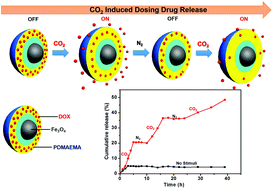CO2-switchable drug release from magneto-polymeric nanohybrids†
Abstract
CO2-responsive well-defined core–shell–corona structure magnetic Fe3O4@SiO2-poly(N,N-dimethylaminoethyl methacrylate) (PDMAEMA) nanocarriers have been developed as efficient drug delivery systems. The hybrid magnetic nanoparticles (MNPs) demonstrated a sandwich structure and highly super-paramagnetic biocompatibility properties as well as gas-responsive behavior. We found that the hydrodynamic radius (Rh) of the magnetic hybrid nanoparticles could be adjusted by alternate CO2/N2 treatment driving a switchable volume transition from contraction to expansion because of the CO2 responsiveness of PDMAEMA. The CO2-triggered protonation of the polymer shell gives rise to an obvious zeta potential change of the nanoparticles. Importantly, the CO2 induced reversible “on–off” transformation makes it possible to perform a dosage release of doxorubicin (DOX) in vitro in a time-controllable manner which is of great significance in controlled drug release. In the presence of CO2, the drug release rate is significantly accelerated, while low drug release could be achieved by removal of CO2 using N2. Moreover, the in vitro cytotoxicity test indicated that the CO2-responsive magnetic nanocarriers have good biocompatibility and could be safely used in living systems.


 Please wait while we load your content...
Please wait while we load your content...